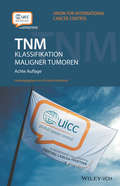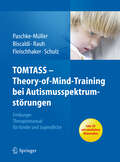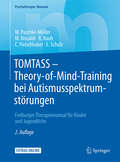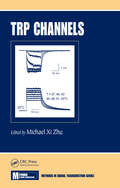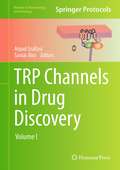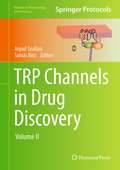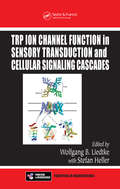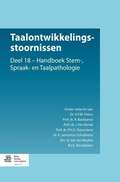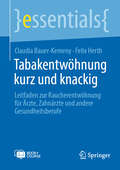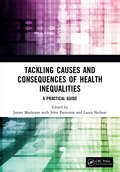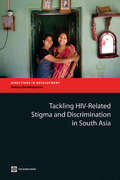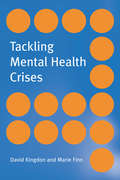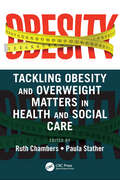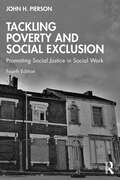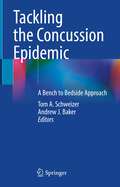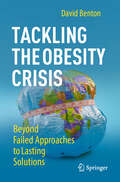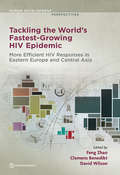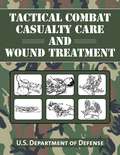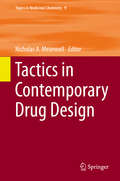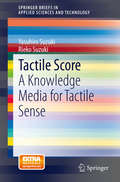- Table View
- List View
TNM: Klassifikation maligner Tumoren
by Christian WittekindDie TNM-Klassifikation ist das weltweit am haufigsten verwendete System fur die Beschreibung der anatomischen Ausbreitung maligner Tumoren, gegliedert in einen klinischen und einen pathologischen Teil. Sie wird in Zusammenarbeit mit der Union for International Cancer Control (UICC) herausgegeben und umfasst im Wesentlichen alle anatomischen Regionen gema? den WHO-Richtlinien zur Klassifikation der Krankheiten in der Onkologie. Die 8. Auflage berucksichtigt die wesentlichen seit 2009 aktualisierten Richtlinien zur Definition der T-, N- und M-Kategorien und der Stadien. Au?erdem werden TNM-Klassifikationen fur einige neu hinzugekommene Tumorentitaten, wie z. B. Thymustumoren, veroffentlicht.
TOMTASS - Theory-of-Mind-Training bei Autismusspektrumstörungen
by Eberhard Schulz Mirjam S. Paschke-Müller Reinhold Rauh Monica Biscaldi Christian FleischhakerDas Therapieprogramm zur Behandlung von Kindern und Jugendlichen mit Autismus gliedert sich in einen theoretischen und einen praktischen Teil. Im Theorieteil werden die Grundlagen des Autismus kurz, präzise und klar verständlich beschrieben. Der Praxisteil, das eigentliche Therapiemanual, besteht aus einheitlich aufgebauten Therapieeinheiten (Modulen), die für die Gruppentherapie mit autistischen Kindern und Jugendlichen eingesetzt werden können. Das Manual enthält klare Handlungsanweisungen und zahlreiche Arbeitsmaterialien.
TOMTASS - Theory-of-Mind-Training bei Autismusspektrumstörungen: Freiburger Therapiemanual für Kinder und Jugendliche (Psychotherapie: Manuale)
by Eberhard Schulz Mirjam S. Paschke-Müller Reinhold Rauh Monica Biscaldi Christian FleischhakerDas Therapieprogramm zur Behandlung von Kindern und Jugendlichen mit Autismus gliedert sich in einen theoretischen und einen praktischen Teil. Im Theorieteil werden die Grundlagen des Autismus kurz, präzise und klar verständlich beschrieben. Der Praxisteil, das eigentliche Therapiemanual, besteht aus einheitlich aufgebauten Therapieeinheiten (Modulen), die für die Gruppentherapie mit autistischen Kindern und Jugendlichen eingesetzt werden können. Das Manual enthält klare Handlungsanweisungen und zahlreiche Arbeitsmaterialien.
TRAIL, Fas Ligand, TNF and TLR3 in Cancer
by Olivier MicheauThis volume provides the current understanding of death receptor's/TLR3 signaling regulation in cancer. Death receptors, including TRAIL-R1, TRAIL-R2, Fas and TNF-RI, owing to their ability to trigger apoptosis and to contribute to the elimination of cancer cells by the immune system have been considered, to variable extent, as important therapeutic targets for cancer therapy. But an increasing body of evidence suggests that some of these receptors may also contribute to tumorigenesis, or that new players such as TLR3 may be targeted for cancer therapy due to their ability to behave like death receptors.
TREATING INFECTIOUS DISEASES IN A MICROBIAL WORLD: Report of Two Workshops on Novel Antimicrobial Therapeutics
by National Research Council of the National AcademiesHumans coexist with millions of harmless microorganisms, but emerging diseases, resistance to antibiotics, and the threat of bioterrorism are forcing scientists to look for new ways to confront the microbes that do pose a danger. This report identifies innovative approaches to the development of antimicrobial drugs and vaccines based on a greater understanding of how the human immune system interacts with both good and bad microbes. The report concludes that the development of a single superdrug to fight all infectious agents is unrealistic.
TRP Channels (Methods in Signal Transduction Series)
by Michael X. ZhuThe rapid expansion of the TRP field has generated a large amount of excellent original work across many different research fields. However, investigators are not necessarily familiar with the pros and cons of the variety of methods used to study TRP channels. Because of functional and genetic diversity, as well as the different physiological roles
TRP Channels in Drug Discovery, Volume I
by Arpad Szallasi Tamás BíróRecent findings have implied a distinct therapeutic potential for drugs targeting Transient Receptor Potential (TRP) channels in a wide variety of diseases, many with no existing satisfactory treatment options. Thus, the TRP superfamily of ion channels has attracted a great deal of well-deserved attention. TRP Channels in Drug Discovery provides a thorough collection of the most up-to-date reviews and protocols on the subject, coming from top experts in the field. Volume I presents a series of state-of-the-art minireviews on the most interesting TRP channels (from TRPA1 to TRPV4), as well as TRP-related protocols involving airways and the genitourinary tract. Written for the Methods in Pharmacology and ToxicologyTM series, this work includes the kind of detailed description and key implementation advice that ensures successful results in the lab. Comprehensive and cutting-edge, TRP Channels in Drug Discovery serves as an ideal reference for graduate students in academic laboratories as well as for pharmaceutical scientists developing new drugs and clinicians interested in novel drugs in the pipeline.
TRP Channels in Drug Discovery, Volume II
by Arpad Szallasi Tamás BíróRecent findings have implied a distinct therapeutic potential for drugs targeting Transient Receptor Potential (TRP) channels in a wide variety of diseases, many with no existing satisfactory treatment options. Thus, the TRP superfamily of ion channels has attracted a great deal of well-deserved attention. TRP Channels in Drug Discovery provides a thorough collection of the most up-to-date reviews and protocols on the subject, coming from top experts in the field. Volume II presents practical methodologies involving models for disorders of the cardiovascular system, the brain, skin, the metabolic system, as well as colitis, cancer, thermosensation, and musculoskeletal disorders. Written for the Methods in Pharmacology and ToxicologyTM series, this work includes the kind of detailed description and key implementation advice that ensures successful results in the lab.<P><P> Comprehensive and cutting-edge, TRP Channels in Drug Discovery serves as an ideal reference for graduate students in academic laboratories as well as for pharmaceutical scientists developing new drugs and clinicians interested in novel drugs in the pipeline.
TRP Ion Channel Function in Sensory Transduction and Cellular Signaling Cascades (Frontiers in Neuroscience)
by Wolfgang B. Liedtke Stefan HellerSince the first TRP ion channel was discovered in Drosophila melanogaster in 1989, the progress made in this area of signaling research has yielded findings that offer the potential to dramatically impact human health and wellness. Involved in gateway activity for all five of our senses, TRP channels have been shown to respond to a wide range of st
Taal: Deel 7 - Handboek Stem-, Spraak- en Taalpathologie
by R. Bastiaanse P.H.O. Dejonckere K. Jansonius-Schultheiss B.J.E. Mondelaers H.F.M. Peters J. Van Borsel Sj. Van der MeulenHet Handboek Stem-Spraak-Taalpathologie verscheen tussen 1997 en 2007 gefaseerd in losse afleveringen. Daarin werd alle kennis op het gebied van de stem-, spraak- en taalpathologie vanuit verschillende disciplines samengebracht. Het Handboek is bestemd voor iedereen die klinisch-praktisch of meer theoretisch is geïnteresseerd, of vanuit een ander vakgebied hiermee in aanraking komt. Voor logopedisten, artsen, linguïsten, spraak- en taalpathologen, audiologen, pedagogen en psychologen in Nederland en België is het Handboek een onmisbare vraagbaak.Deel 7 geeft een overzicht van de processen van het produceren en begrijpen van gesproken en geschreven taal. Er is veel aandacht voor de manier waarop kinderen deze processen leren. De taalstoornissen komen in de delen 18, 19 en 20 aan bod.
Taalontwikkelingsstoornissen
by R. Bastiaanse P.H.O. Dejonckere K. Jansonius-Schultheiss B.J.E. Mondelaers H.F.M. Peters J. Van Borsel Sj. Van der MeulenHet Handboek Stem-Spraak-Taalpathologie verscheen tussen 1997 en 2007 gefaseerd in losse afleveringen. Daarin werd alle kennis op het gebied van de stem-, spraak- en taalpathologie vanuit verschillende disciplines samengebracht. Het Handboek is bestemd voor iedereen die klinisch-praktisch of meer theoretisch is geïnteresseerd, of vanuit een ander vakgebied hiermee in aanraking komt. Voor logopedisten, artsen, linguïsten, spraak- en taalpathologen, audiologen, pedagogen en psychologen in Nederland en België is het Handboek een onmisbare vraagbaak.Deel 18 is geheel gewijd aan taalontwikkelingsstoornissen.
Tabakentwöhnung kurz und knackig: Leitfaden zur Raucherentwöhnung für Ärzte, Zahnärzte und andere Gesundheitsberufe (essentials)
by Felix Herth Claudia Bauer-KemenyDieses Essential plus course möchte allen im Gesundheitswesen tätigen Personen aufzeigen, wie Sie schnell und einfach, aber dennoch effektiv Tabakentwöhnung im Klinik- oder Praxisalltag durchführen können. In Verbindung mit dem dazugehörigen Online-Kurs lernen Sie die Methoden der Kurzintervention kennen, werden über die zur Tabakentwöhnung zugelassenen Medikamente informiert und erfahren, wo und wie entwöhnungswillige Rauchende weitere Unterstützungsangebote erhalten, damit ein Rauchstopp auch wirklich gelingen kann. Den kostenlosen Zugang zum Online-Kurs finden Sie direkt im Buch.
Tackling Causes and Consequences of Health Inequalities: A Practical Guide
by James Matheson John Patterson Laura NeilsonAddressing health inequalities is a key focus for health and social care organizations, yet this is the first book to explore how best frontline health workers in areas of deprivation can address these problems. Aimed at doctors and their wider multidisciplinary teams, this book provides key knowledge and practical advice on how to address the causes and consequences of health inequalities to achieve better outcomes for patients. Considering the psychological, financial and social aspects of well-being as well as health concerns, this book offers a concise but comprehensive overview of the key issues in health inequalities and, most importantly, how practically to address them. Key Features Comprehensively covers the breadth of subjects identified by RCGP’s work to formulate a curriculum for health inequalities The first book to address the urgent area of causes and consequences of health inequalities in clinical practice. Chapters are authored by expert practitioners with proven experience in each aspect of health care. Applied, practical focus, demonstrating approaches that will work and can be applied in ‘every’ situation of inequality. Provides evidence of how community based primary care can make a change.
Tackling HIV-Related Stigma and Discrimination in South Asia
by Dara Carr Laura Nyblade Anne Stangl Laura Brady Mariam Claeson Traci EckhausAlthough overall HIV prevalence in South Asia is low, the widespread stigma attached to HIV and AIDS impedes efforts to reach people most in need of prevention, care, and treatment services. To address this challenge, the 2008 South Asia Region Development Marketplace partnership, led by the World Bank, launched a competitive grants program to support innovative community approaches. 'Tackling HIV-Related Stigma and Discrimination in South Asia' summarizes the monitoring, evaluation, and case study data and documents successful community innovations. Twenty-six community groups in Afghanistan, Bangladesh, India, Nepal, Pakistan, and Sri Lanka received funds. The initiatives involved a broad spectrum, including vulnerable groups as well as people living with HIV, the media, local government authorities, health workers, and religious leaders. The interventions used traditional cultural and media approaches to discuss taboo subjects. The reach of the initiatives was amplifi ed by involving opinion leaders. The strategies engaged marginalized groups to design and lead the interventions and to facilitate contact between groups experiencing stigma and the general public to reduce fears and misconceptions about transmission. Projects that combined economic and stigma reduction interventions helped the marginalized populations to overcome the internalized stigma and become empowered to advocate for their rights. 'Tackling HIV-Related Stigma and Discrimination in South Asia' identifies effective strategies to raise awareness and reports on shifts-albeit slow-of attitudes, norms, and behaviors. Through its recommendations for successful interventions to reduce barriers to effective HIV prevention, care, and treatment programs, the book provides a strong foundation on which to build stigma reduction efforts in the region and world.
Tackling Health Inequalities: Reinventing the Role of Environmental Health (Routledge Focus on Environmental Health)
by Surindar Kishen DhesiAlthough environmental health has received some recognition as a field which can positively impact on the social determinants of health, it remains little known outside its immediate sphere of influence. There is also limited literature available to support the potential impact of the profession in public health policy circles, and there has been an overreliance on anecdotal rather than firm evidence. This book presents the findings of an empirical research project focussed on public health policymaking (English Health and Wellbeing Boards), health inequalities and environmental health and provides an insight to the environmental health profession and routes of impact and influence. It discusses environmental health in the context of public health, the role of the profession, issues of visibility and opportunities for impact in today’s policy landscape. In particular, a focus on the local government context is timely given the shifting of the public health function from the National Health Service to local authorities. This book is essential reading for students, practitioners and policymakers in the fields of environmental health and public health.
Tackling Mental Health Crises
by David Kingdon Marie FinnTackling Mental Health Crises provides a practical guide to combining social and psychological responses to mental health problems. David Kingdon and Marie Finn look at what constitutes a crisis, be it an individual crisis presentation or a situational crisis for services. They reject current diagnostic approaches to mental health, focussing instead on a symptom-led approach and keeping an awareness of the intervention experience for clients and carers throughout. Subjects covered include: engaging and assessing the client risk assessment and management emotional, behavioural, cognitive and physical presentations service teams and settings. The emphasis throughout is on taking a holistic look at crisis prevention and management, encompassing both the work that takes place at an individual level and the wider impact of societal and political issues. Containing clear direction and practical advice, combined with numerous case studies and commentary from users and carers themselves, this book will be of great use to anyone involved with dealing with mental health crises.
Tackling NHS Jargon: Getting the Message Across
by Sarah CarrUsed properly jargon can be effective, but used incorrectly it can damage communications, waste time and money, and harm public, patient and staff relations. This book will enable and encourage readers to use language that the intended audience will understand. It provides practical advice based on the author's experience of producing National Health Service documents and contains explanations of common NHS jargon, with alternatives. Plain speaking and writing techniques are included, and there are numerous examples from real NHS management communications. This is an invaluable book for Health Service managers, clinicians with management responsibilities and all those responsible for communicating information about healthcare.
Tackling Obesity and Overweight Matters in Health and Social Care
by Ruth Chambers Paula StatherThis practical guide helps health or social care professionals across all settings to understand how important it is to prevent and manage their service users’ overweight and obesity, and motivate them to achieve and maintain a healthy weight, so reducing their risk of associated health conditions such as diabetes and now COVID-19. Obesity and associated health problems represent a growing health burden around the world, with rates throughout Europe increasing sharply over the last forty years, second only to the United States and closely followed by many nations in Asia. The book will be an invaluable manual for general practice, primary care and community clinicians, practice and community nurses and dietitians and a go-to reference for health professionals across all medical specialties and related support services, as well as medical education, public health and social care worker professionals.
Tackling Poverty and Social Exclusion: Promoting Social Justice in Social Work
by John H. PiersonIn highly unequal Britain, poverty and social exclusion continue to dominate the lives of users of social work and social care services. At the same time, years of austerity combined with welfare reform have changed the context in which services are delivered in a society roiled by Brexit, Covid, Black Lives Matter and women rallying under the banner, “Me‑too”.This fourth edition lays out the ways and means for practitioners to tackle the deprivation and destitution of service users. Fully revised and expanded, it introduces new material that tracks changes and developments in policy and practice. Statutes, benefit rules and relevant research are discussed as part of the necessary knowledge base for practitioners. Greater attention than in previous editions is paid to: local authority commissioning, the impact of social media on the mental health of young people, substandard housing and working with transgender youth.Preparing practitioners to engage directly with the social and personal circumstances facing excluded individuals and their families, this book explains the development of the concept of social exclusion as a framework for understanding the impact of poverty and other deprivations in users’ lives, and locates that framework within social work values of social justice while acknowledging the many challenges to those values. The focus is on practice throughout with boxed extracts from key policies and guidelines along with questions for readers to ponder through up‑to‑date examples, activities and exercises in each chapter. Case studies from public, private and voluntary sectors are drawn from across the United Kingdom, to illuminate the way forward for poverty‑aware social work.Tackling Poverty and Social Exclusion will be required reading for all BA and MA social work degrees across the United Kingdom.
Tackling the Concussion Epidemic: A Bench to Bedside Approach
by Tom A. Schweizer Andrew J. BakerThis state-of-the-art book brings together the full range of issues that can inform care for patients experiencing the effects of concussion. Written by an international panel of experts and edited by a critical care physician and by a cognitive neuroscientist, the book serves as a primer of the various domains of study and application, while providing clinical insights and evidence to bring towards treatment. Chapters span the basic mechanics and pathophysiology of concussion, through its assessment, management, and complications. Comprehensive and timely, this book is accessible to healthcare professionals, and researchers eager to learn something about this field.
Tackling the Obesity Crisis: Beyond Failed Approaches to Lasting Solutions
by David BentonThe obesity epidemic reflects a failure to understand how meals are chosen. Government initiatives have failed, and most people are unable to control their weight. In this book, an internationally recognized expert on diet and behaviour, discusses the common misunderstandings that have created the epidemic, and suggests how obesity could be reduced.After dieting the body needs fewer calories and you are likely to put on weight. Many people do not understand how to control their weight and rely on ideas that are simply wrong. Natural foods are seen as healthier when they are not. Ultra-processed foods are seen as a problem when the method of production is unimportant. There is little evidence that removing sugar from the diet, banning advertising to children, adding calories to menus, or providing nutritional information on packaging reduces obesity. In fact, removing fat from the diethas increased obesity.One conclusion is that current approaches have no chance of preventing obesity. Without new ways of dealing with obesity, it will inevitably increase, reducing life expectancy after decades of disease.So, what needs to change? One root cause of obesity is poverty. The way infants are fed in the first years of life determines the likelihood of obesity in adulthood. Without the development of low-calorie foods, little can be done. Since health policy depends on individuals changing their behaviour, they need to understand how to control their weight. Ambitious in scope, the author deals with the topic in an eye-catching and easy to understand manner, illustrated with colourful analogies and unusual and amusing facts. A refreshing novel perspective is offered that will be of interest to everyone wishing to control their body weight.
Tackling the World's Fastest-Growing HIV Epidemic: More Efficient HIV Responses in Eastern Europe and Central Asia (Human Development Perspectives)
by David Wilson Feng Zhao Clemens BenediktThe Eastern Europe and Central Asia region has the world’s fastestgrowing HIV epidemic. Although still concentrated, the epidemic has diversified, affecting several key populations in many countries. This change has increased the number of people in need, the ways the epidemic can spread, and the complexity of formulating an effective strategy to combat it. At the same time, international funding is insufficient to cover the growing need, and domestic plans to cover the funding gaps, in many cases, fall short. In this environment, the need to use data to make the best possible decisions about using available funds is essential. Tackling the World’s Fastest-Growing HIV Epidemic tells the story of how, in 11 countries across Eastern Europe and Central Asia, small groups of decision-makers and experts came together to carry out innovative, groundbreaking analyses for each country. It details the steps these nations have taken to strengthen their HIV programs based on the findings while highlighting critical issues for the road ahead. In so doing, the book also shows the potential of what can be done with a mathematical model and how it can support real-life improvements in policy and more efficacious budget allocations. It is the record of a unique undertaking to improve public health investments that offers lessons for many communities.
Tactical Combat Casualty Care and Wound Treatment
by U.S. Department of DefenseMilitary surgeons must assume a leadership role in combat casualty care in circumstances that are far less than ideal. This handbook provides much of the information needed to tackle these issues and features state-of-the-art principles and practices of forward trauma surgery as used by military physicians in far flung locations around the globe. In this volume you’ll learn such integral skills as: * Tactical field care * Field dressing * Applying pressure dressing * Treating burns * Treating inhalation injuries * And more! Tactical Combat Casualty Care and Wound Treatment is the most trusted and up-to-date manual offered by the Department of Defense for military medical personnel in the field.
Tactics in Contemporary Drug Design
by Nicholas A. MeanwellMedicinal chemistry is both science and art. The science of medicinal chemistry offers mankind one of its best hopes for improving the quality of life. The art of medicinal chemistry continues to challenge its practitioners with the need for both intuition and experience to discover new drugs. Hence sharing the experience of drug research is uniquely beneficial to the field of medicinal chemistry. Drug research requires interdisciplinary team-work at the interface between chemistry, biology and medicine. Therefore, the topic-related series Topics in Medicinal Chemistry covers all relevant aspects of drug research, e. g. pathobiochemistry of diseases, identification and validation of (emerging) drug targets, structural biology, drugability of targets, drug design approaches, chemogenomics, synthetic chemistry including combinatorial methods, bioorganic chemistry, natural compounds, high-throughput screening, pharmacological in vitro and in vivo investigations, drug-receptor interactions on the molecular level, structure-activity relationships, drug absorption, distribution, metabolism, elimination, toxicology and pharmacogenomics. In general, special volumes are edited by well known guest editors.
Tactile Score
by Yasuhiro Suzuki Rieko SuzukiThis book deals with one of the most novel advances in natural computing, namely, in the field of tactile sense analysis. Massage, which provides relaxation and stimulation for human beings, is analyzed in this book for the first time by encoding the motions and tactile senses involved. The target audience is not limited to researchers who are interested in natural computing but also includes those working in ergonomic design, biomedical engineering, Kansei engineering, and cognitive science.
